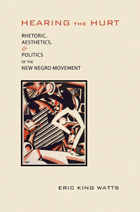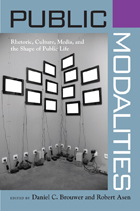2 books about Watts, Eric King

Hearing the Hurt
Rhetoric, Aesthetics, and Politics of the New Negro Movement
Eric King Watts
University of Alabama Press, 2012
Hearing the Hurt is an examination of how the New Negro movement, also known as the Harlem Renaissance, provoked and sustained public discourse and deliberation about black culture and identity in the early twentieth century.
Borrowing its title from a W. E. B. Du Bois essay, Hearing the Hurt explores the nature of rhetorical invention, performance, and mutation by focusing on the multifaceted issues brought forth in the New Negro movement, which Watts treats as a rhetorical struggle over what it means to be properly black and at the same time properly American.
Who determines the meaning of blackness? How should African Americans fit in with American public culture? In what way should black communities and families be structured? The New Negro movement animated dynamic tension among diverse characterizations of African American civil rights, intellectual life, and well-being, and thus it provides a fascinating and complex stage on which to study how ideologies clash with each other to become accepted universally.
Watts, conceptualizing the artistic culture of the time as directly affected by the New Negro public discourse, maps this rhetorical struggle onto the realm of aesthetics and discusses some key incarnations of New Negro rhetoric in select speeches, essays, and novels.
[more]

Public Modalities
Edited by Daniel C. Brouwer and Robert Asen
University of Alabama Press, 2010
Illustrates a modalities approach to the study of publics
This book explores the ways that scholars, journalists, politicians, and citizens conceive of “the public” or “public life,” and how those entities are defined and invented. For decades, scholars have used the metaphors of spheres, systems, webs, or networks to talk about, describe, and map various practices. This volume proposes a new metaphor—modalities—to suggest that publics are forever in flux, and much more fluid and dynamic than the static models of systems or spheres would indicate—especially in the digital age, where various publics rapidly evolve and dissipate.
Contributors to the volume—employing approaches from the fields of communication studies, English, sociology, psychology, and history—explore a broad range of texts and artifacts that give rise to publics, and discuss what they reveal about conceptualizations of social space. By focusing on process in public engagement, these scholars highlight questions of how people advance their interests and identities, and how they adapt to situational constraints.
Bringing together scholars in rhetorical, cultural, and media studies, this collection of new case studies illustrates a modalities approach to the study of publics. These case studies explore the implications of different ways of forming publics, including alternative means of expression (protests, culture jamming); the intersection of politics and consumerism (how people express their identities and interests through their consumer behavior); and online engagement (blogs as increasingly important public fora). In doing so, they raise important questions of access, community, and political efficacy
This book explores the ways that scholars, journalists, politicians, and citizens conceive of “the public” or “public life,” and how those entities are defined and invented. For decades, scholars have used the metaphors of spheres, systems, webs, or networks to talk about, describe, and map various practices. This volume proposes a new metaphor—modalities—to suggest that publics are forever in flux, and much more fluid and dynamic than the static models of systems or spheres would indicate—especially in the digital age, where various publics rapidly evolve and dissipate.
Contributors to the volume—employing approaches from the fields of communication studies, English, sociology, psychology, and history—explore a broad range of texts and artifacts that give rise to publics, and discuss what they reveal about conceptualizations of social space. By focusing on process in public engagement, these scholars highlight questions of how people advance their interests and identities, and how they adapt to situational constraints.
Bringing together scholars in rhetorical, cultural, and media studies, this collection of new case studies illustrates a modalities approach to the study of publics. These case studies explore the implications of different ways of forming publics, including alternative means of expression (protests, culture jamming); the intersection of politics and consumerism (how people express their identities and interests through their consumer behavior); and online engagement (blogs as increasingly important public fora). In doing so, they raise important questions of access, community, and political efficacy
[more]
READERS
Browse our collection.
PUBLISHERS
See BiblioVault's publisher services.
STUDENT SERVICES
Files for college accessibility offices.
UChicago Accessibility Resources
home | accessibility | search | about | contact us
BiblioVault ® 2001 - 2024
The University of Chicago Press









